Bual or Boal as the Portuguese spell it, is a white grape that immediately appeals to those who enjoy Madeira as it provides ethereal aromatics and perfect balance between medium-sweet torrefacted flavors and crisp acidity that allows it to age well for centuries.

Article and photos by Roy Hersh © October 2014
The day had finally arrived and upon reaching the restaurant venue where our event was to be held, my anticipation was palpable. Mannie Berk, the owner of The Rare Wine Co. was already present in the large and well-appointed banquet space, ensuring the decanters and bottles were properly organized by the handful of service staff and management.
Shortly thereafter, the pouring began and the caramelized essence of Bual slowly permeated the entire room as our guests started to arrive on the scene. Most had traveled great distances to take part in this unique Madeira tasting. It is not every day that we get to drink twenty wines with an average age of more than 170 years and a combined age exceeding 3,400 years. At the moment, all seemed right with the world.
Over the course of the next six hours, all participants would leisurely sample and re-taste the wines from each flight before discussing their impressions with the group. In doing so, we found that not only were these Bual bottlings still alive, but the majority exemplified why Madeira is not only a world-class category of wine, but indubitably the best aging wine type on the planet.
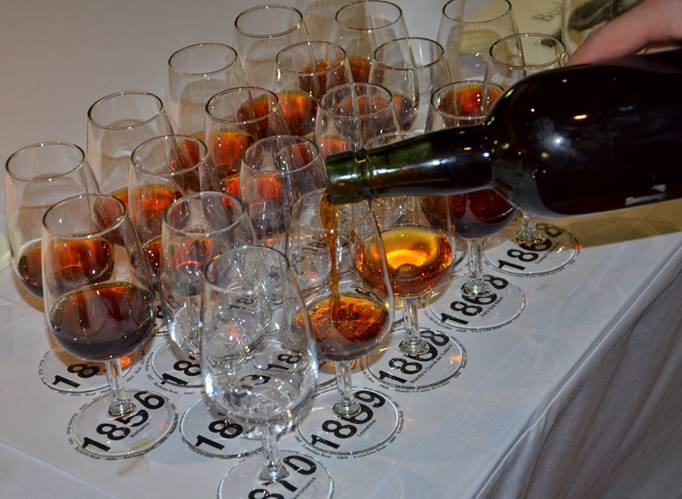
The participants for The Beauty of Bual tasting were:
- Justin Ashourian - Florida
- Mannie Berk - Connecticut
- David Boobyer - UK
- Paul Day - UK
- Marco DeFreitas - Connecticut
- Ricardo Freitas - Madeira
- Alan Gardner - Canada
- Roy Hersh - Washington
- Eric Ifune - Nevada
- Andrew Jones - Cayman Islands /NY
- Mark Lee - California
- Robert Maliner - California
- Richard Mayson - Florida
- Steve Pollack - UK
- Jens Quistgaard - California
- David Shapiro - Maryland
- Steve Shapiro - Maryland
- David Spriggs - California
- Bob Stern - Pennsylvania
The Genesis
After launching the successful Transcendental Terrantez Tasting in 2012 and last year’s Velhissimo Verdelho event, we decided to continue the Madeira momentum and featured the Bual grape this past spring.
What began as a fine collaboration between friends, culminating in a “best of the best” Terrantez Madeira tasting a couple of years ago; Mannie Berk and I have enjoyed co-organizing these distinctive tutored tastings that encourage participants to share their thoughts after each flight. We all learn together!
To pay it forward, “The Beauty of Bual” took center stage on April 5th 2014 in New York City, once again held at the award winning denizen of fine dining, Del Posto Restaurant. Realizing that Bual has a significantly larger palette to choose from than the grapes previously presented, planning began a half year in advance. We agreed that in order to maintain the high standard set in recent years, in 2014 all of the selected Madeiras were pre-Phylloxera bottlings of Bual.
Our 3rd annual Madeira tasting in this series provided a broad swath of at least eight producers and twenty rare and singular Bual bottlings. The vintages began with a youngster from 1870, (144 years of age) and proceeded back through the 19th century to 1802. To add further intrigue to this year’s tasting we chose to showcase extraordinary flights from both 1863 -- think Battle of Gettysburg and for our British friends in attendance, the first section of the London Underground Railway (Paddington to Farringdon Street) was officially opened; as well as the exemplary vintage of 1868. This particular pair of historic years is considered the finest of all pre-Phylloxera Bual vintages.
Following our formal tasting, we adjourned for a sumptuous Italian dinner created by Executive Chef Mark Ladner. His culinary talent is exceptional and not long ago he brought the great honor to Del Posto, which received its Michelin Star (and many other awards) under his watch. We were fortunate to have Jeff Porter’s (the uber-talented Wine Director) skilled service staff looking after our bottles of Madeira and dinner wines. We’re pleased to continue working with this team of well-trained professionals, entrusting them to once again make us feel right at home.
Our sincere thanks for the generosity of all our guests, many of whom traveled from across the country and several that crossed the Atlantic to join in this memorable Madeira party. We were all humbled by our good fortune in experiencing a tasting of such rare and historic bottlings and the opportunity to share so many legendary examples of pre-Phylloxera Boal.
All bottles of Boal were shipped by their owners to Mannie Berk, who meticulously decanted them all, eight days prior to our event, with two exceptions which are noted in the accompany notes. The invitees are known to be some of the world’s greatest Madeira collectors in addition to a couple of journalists who specialize in Portuguese wines and our honored guest, Ricardo Freitas, proprietor and winemaker at Vinhos Barbeito.
Please note: There is a detailed historical perspective of each wine by Mannie Berk (MB), which will appear in italics preceding my tasting notes included below (RH). All auction sales data is from Noel Cossart's Madeira the Island Vineyard, 2nd Edition, The Rare Wine Co., 2011. Additionally, Richard Mayson, a participant in our tasting, graciously wrote a brief on the Boal grape, and it is presented at the end of this article.
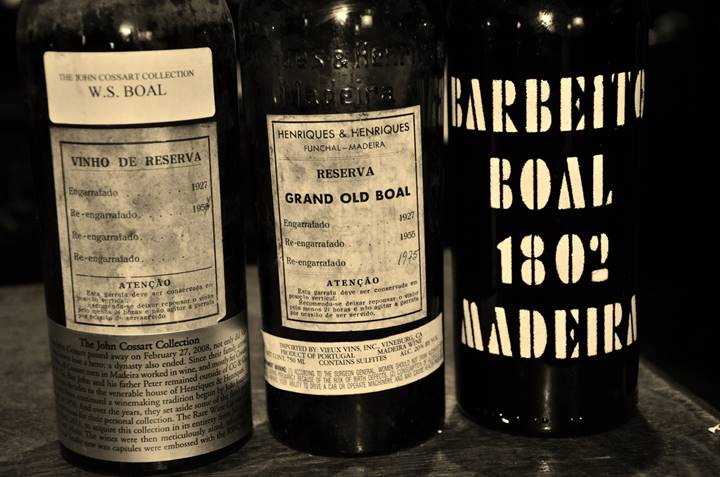
MB: 1870 Barbeito Boal "RV"
This is a family wine from Teresa and Ricardo Vasconcelos, the parents-in-law of Ricardo Freitas’ late sister. Ricardo acquired the wine, in demijohn, in 2008. Ricardo believed that too long aging in demijohn had made the wine overly austere, and so he returned it to cask for a few months, finally bottling it in the fall of that year. It was one of the last old wines that Ricardo had to work with in the old Barbeito winery that was demolished shortly thereafter.
RH: 1870 Barbeito “RV” Boal Vintage Madeira – Light-medium cherry wood color with a gold rim. Exotic nose that consisted of mace, quince paste, subtle VA, cane sugar, sautéed onion, clove and a slight hint of mustiness. A few hours later, scents of maple and banana emerged with delicate baking spice too. Light weight, graceful and texturally smooth, with a round lemony character and zesty acidity in a rich and dry style that tends towards the Verdelho spectrum. Fine flavors of spiced vanilla bean, dried dates, Christmas fruit cake and a liqueur-like lingering note on the finish. A solid and tasty Boal, but it lacks a sense of intensity in the mid-section and finish. 90 points 4/5/14
MB: 1869 Lomelino Boal
This bottle passed through a Sotheby Parke Bernet auction in New York in 1977, and then more recently a Zachy's auction. The highly respected firm of T.T.C. Lomelino was founded in the 19th century by Tarquinio Torquato da Câmara Lomelino, and after his death was run by Carlo de Bianchi, grandfather of Noël Cossart. However, this is probably not a Lomelino wine, but simply a wine bottled under the Lomelino label—one of many brands used by the Madeira Wine Association (MWA) from the 1930s on.
RH: 1869 Lomelino Boal Vintage Madeira – Coffee color with a broad gold rim, this Lomelino possessed one of the darkest hues in the entire tasting. A fragrant distinctive essence includes torched brown sugar, saline, saddle leather, teriyaki sauce, glove leather and a whiff of charred wood. Medium-full body weight and densely concentrated, with caramel, tropical fruit and loads of orange peel bolstered by crisp acidity which showcased the excellent balance of this fine bottling. The sweet silhouette transitioned into a lingering sense of butterscotch and mahogany that remained present for minutes after swallowing. A lovely Lomelino. 94 points 4/5/14
MB: 1868 Blandy's Cama do Lobos
This rare bottle was purchased by Paul Day from an auction of the Tour d'Argent cellar in Paris. It is a classic example of glass-aged Bual, having spent just 18 years in wood, prior to being bottled in 1886. One hundred and twenty years is a very long time for a Madeira to remain in bottle (particularly after such a short stay in wood). We gave it a few extra days in the decanter. We’ll see if it needed much more time than that.
RH: 1868 Blandy’s Cama do Lobos Boal Vintage Madeira – This exhibited the lightest color of all Boals in the tasting, with a lightly hued amber-orange and clear meniscus. Bottled young in 1886 and then stored at 95 degrees F. in the canteiro rooms of the Blandy’s lodge. This bottle was from the esteemed cellar of Tour d’Argent. Initially some serious bottle stink which faded in glass and later, a rather reticent aromatic profile requiring loads of swirling to coax hints of ripe Seckle pear, cinnamon poached apple and a coffee-toffee note. It was light in weight and exhibited mild acidity that could’ve use a bit more pop to enhance the smooth creamy texture. Dry for a Boal, this Blandy’s bottling sat in glass for 120 years and required a 10 day decant. It finished with a persistent dry and Cognac-like impressively long aftertaste with a delicate hint of VA. 91 points 4/5/14
MB: 1868 Very Old Boal “EBH”
The 1868 “EBH” Very Old Boal is a famous wine. The initials stand for Eugenia de Bianchi Henriques, who had two famous grandfathers: on her mother’s side, Tarquinio Torquato da Câmara Lomelino, the founder of Lomelino, and on her father’s, Carlo de Bianchi, who ran Lomelino after Tarquinio’s death. She was also the aunt of Noël Cossart and wife of Tiburcio Henriques, scion of Câma do Lobos’ important Henriques family. Such connections explain the great Boals that appeared under Eugenia’s initials from vintages like 1869, 1870 and 1893. But the 1868 is the most revered. In his 2002 book, Vintage Wine, Michael Broadbent wrote of it: “Translucent, ethereal, herbaceous, full, rich, lovely texture, great length ... A famous wine, surpassed only by the 1862 (HMB) Terrantez. Five stars.” This bottle was purchased decades ago at Christies in London by Bob Maliner.
RH: 1868 Very Old Boal “EBH” Vintage Madeira – Very dark coffee color with a clear golden edge. It offered a superlative mélange of whiffs of espresso bean, coconut, peanut brittle, sugar cane and a smoky edginess emerged as it sat in glass for a few hours. Although medium weight, this EBH was viscous yet vinous and mouthfilling, rich with mid-palate density and multifaceted layers. Off-dry and exhibiting laser-like acidity that provided focus and precision to this excellent bottling. Quite refined and filled with tantalizing tastes of zesty apricot marmalade, pumpkin spices and dried peach. Sublimely round and epitomizing finesse, the incredible retro-nasal mayhem and length of the finish were quite extraordinary. A marvelous and memorable Madeira from 1868! 95 points 4/5/14
MB: 1868 Cossart Gordon Very Old Boal “EBH”
The 1868 “EBH” Very Old Boal has appeared under several brands, including Cossart Gordon. This bottle has identical stenciling to the previous wine (which has no shipper name), and it bears the same "Very Old Boal" paper strip label. It will be interesting to compare the two examples, and for those whose memories are good, the Leacock 1868 “EBH” Very Old Boal, which a number of us have tasted.
RH: 1868 Cossart Gordon Very Old Boal “EBH” Vintage Madeira – Another exemplary 1868, highlighting the reason we chose to feature this vintage alongside the 1863s. Similar in color to the EBH above with slightly more glints of ruby in the core. The differences from that bottling were minimal and I have to believe these were the exact same wines bottled by at least two shippers back in the day. This Cossart Gordon was far more restrained early on, but exhibited more unctuousity overall. The aromas and flavor profile varied only slightly and side-by-side I preferred the other version slightly more, mostly due to the longer length of its aftertaste. 94 points 4/5/14
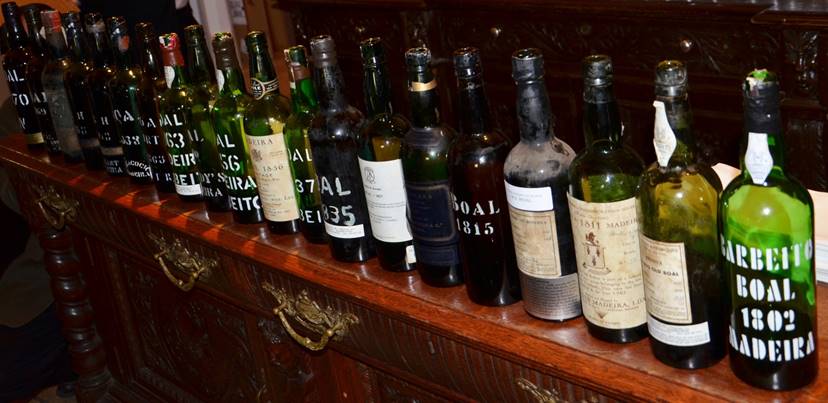
MB: 1863 Leacock Boal
Boal 1863 has appeared under a number of Madeira Wine Association labels, including Leacock, Cossart Gordon, Blandy's and Welsh Bros. Presumably all the bottlings share a common origin. This particular bottle was bottled in 1978 and imported into the U.S. by World Shippers of Philadelphia.
RH: 1863 Leacock’s Boal Vintage Madeira – Dark tea like appearance and fully transparent with a narrow greenish meniscus. The fragrances of this wine were nothing short of profound with a meaty bouillon cube note dominating early on, but continued nosing of this particular glass provided hints of lime leaf, tootsie roll, sea salt, roasted espresso, mulled cider and leather. An incredible nose! Actually the palate was not quite as off-the-charts, delicious nonetheless, with a suave silky texture and bracing acidity that won me over early on. Dry entry with lemon and grapefruit zest essence, but as this Leacock’s continued to morph over several hours, flavors of toffee, sweet candied orange and a fascinating roasted meat nuance emerged along with a sweet date and nut bread appeal. It’s quite captivating on the medium-long finish. Just missing a bit of oomph at the end! 94 points 4/5/14
MB: 1863 Barbeito Boal
This wine is very well-known to American Madeira lovers. There were many different bottlings, spanning close to a half century. Along with the equally famous 1795 Terrantez and 1834 Malvasia, the 1863 Boal was part of Mario Barbeito's opening stock when he founded his eponymous company in the late 1940s.This particular bottle was imported by The Rare Wine Co. in the late 1990s and was probably bottled in the mid-1990s.
RH: 1863 Barbeito Boal Vintage Madeira – Medium-maple color with a greenish-gold rim. This Barbeito typifies the beauty of Boal, the nose remarkably fresh with distinctive notes of maple, pine resin, hazelnut, quince paste and salted caramel. There was a greater sense of hedonism to this particular Barbeito bottling, demonstrating why 1863 is not only one of the all-time greatest years for Portuguese fortified wines, but Boal in particular. The ethereal nature of the mid-palate was nothing short of mind-blowing, gaining complexity as it blossomed in glass. Both the penetrating salivary gland tingling acidity as well as the impressive waves of complex flavors had me returning to this glass throughout the course of the tasting. Nuanced notes of citrus, sweet candied pecan, caramel, nutmeg, panoply of elusive spices along with a bittersweet interplay on the finish was profound in its lingering character and elegance, stemming from twenty plus years in bottle after eons concentrating in wood. A most scintillating Boal and the best bottle to this point in the tasting. 96 points 4/5/14
MB: 1863 Teixeira Boal "JRT"
Justin kindly donated this bottle to make our flight of ‘63s even richer. The bottle's back label reads: “This old madeira formed part of the private reserve of João Romão Teixeira (1864-1933), a prominent wine producer at Lugar de Baixo in south west Madeira. In the 1950s, the wine was transferred to glass demijohns form the oak casks in which it had been matured, and was bottled, unrefreshed, in 1987. Of a total of 320 bottles, this is No. 0066." According to Peter Reutter of Madeirawineguide.com, Teixeira was descended "from one of the captains that sailed with Zarco when he claimed Madeira island for Portugal.”
RH: 1863 Texeira “JRT” Boal Vintage Madeira – I knew little about this wine prior to tasting it. The nose was striking with its exotic black tea essence and captivating scents of golden raisin, salty sea breeze, sweet vanilla bean, antique furniture and roasted coffee to round out the richly scented profile. The smoky/roasted essence translated directly to the palate and the acid was sharply focused retaining freshness and providing requisite balance to the sweet flavor of this Texeira. An elusive chemistry existed between citrus and tropical fruits further nuanced by nutty praline which added greater depth, while an undeniable roasted flavor led to intricate torrefacted characteristics. Some of the Madeira cognoscenti suggested this may have spent too long in wood and therefore lacked some subtlety. Possibly so, but the acidity, peripherals and persistence delivered the goods for this scribe. 93 points 4/5/14
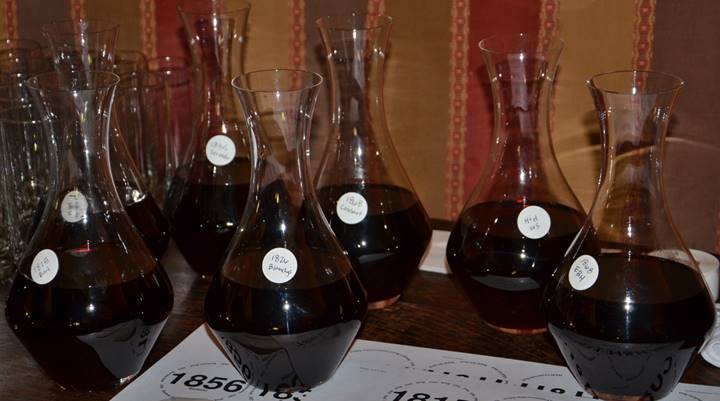
MB: 1860 Blandy's Bual
Unlike many other Blandy vintage Madeiras, this does not seem to have appeared under other MWA/MWC labels. However, other 1860 Buals exist outside the orbit of the Madeira Wine Association. These include an 1860 Grand Old Boal from Henriques & Henriques and a bottle of 1860 Bual (without a shipper's name) that belonged to Noël Cossart. The latter of course very possibly came from the MWA. Legitimately rare, only three bottles of the Blandy's 1860 are noted in the Cossart book as being sold at auction. The bottle we’re tasting today, thanks to Steve Shapiro, was purchased in the UK. There was no seal of guarantee on the neck, which might have helped to establish an approximate date of bottling and/or export.
RH: 1860 Blandy’s Boal Vintage Madeira – Medium dark chestnut appearance with a golden-green rim. After an initial tightly wound nose, time in the glass unfurled unique aromas and presented impressions of tobacco, iodine, menthol and lemon zest. The palate presence was far more forthcoming with a creamy texture, well developed flavors of tapenade, lime zest, green tea, soy and butterscotch that arrived shortly after swallowing. A pleasant bottling but not one that really stood out from the crowd, as the acidity was not edgy enough and the mid-range was modest as was the finish. 92 points 4/5/14
MB: 1856 Leacock Bual
Coming just four years after the arrival of Oïdium, 1856 Madeiras are rare—from any grape variety. In fact, of the two vintage Madeiras noted in the Cossart book’s auction records, both are Buals, and both appear in this tasting. They are the Leacock and Barbeito examples. Do they have common origins? Perhaps the tasting will give us some clues. Only two bottles of 1856 Leacock were noted as having been sold at major auctions, and none in the past two decades. This particular bottle was imported into the US in the 1960s by Leacock’s agent at that time, Julius Wile.
RH: 1856 Leacock’s Boal Vintage Madeira – The appearance of dark cocoa with an amber edge. The 1856 seemed to be either under-decanted or was destined to retain some serious bottle stench. There was a ton of VA, dominant herb, plastic and sun-dried tomato notes as well as far more pleasing fragrant scents of lemon/lime, honey and toffee. Light in weight, delicate, a bit spirituous and warm if not downright hot, there were some nice flavors including nectarine, apricot marmalade, mint, sweet potato pie and cinnamon Red Hots. By comparison it lacked verve, depth, length and was one of the weaker Boals. That said, its strength was its elegant and nuanced taste. 90 points 4/5/14
MB: 1856 Barbeito Boal
Barbeito's 1856 Boal is also rare, with only 8 bottles noted at auction in Cossart. The Rare Wine Co. was fortunate to buy a few bottles from the Barbeito family in 2002, and that is the source of this particular bottle. Ricardo Freitas is sure it came from his grandfather Mario Barbeito, who bottled some of the wine with paper labels in the 1970s. Our bottle is stenciled and may be of a somewhat later date.
RH: 1856 Barbeito Boal Vintage Madeira – Our luck turned with the 1856 vintage as this bottle was no better than the previous one. Were they in fact the same? A cloudy appearance and light yellow edge. Not your typical nose with pipe tobacco, tar, burnt rubber tire, and a powerful medicinal note which made me reluctant to even take a sip. It tasted of burnt caramel with a weird plastic quality and a clipped finish. Something was clearly defective here. Not Rated 4/5/14
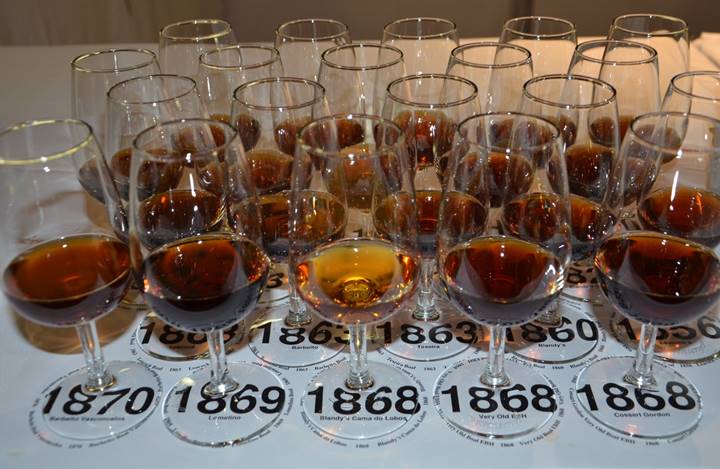
MB: 1837 Barbeito Boal
This bottle was purchased from the Barbeito family at the same time as the 1856. Ricardo believes it may be the Acciaioly 1837 Bual, since his family did the decanting, airing and rebottling of the Acciaioli wines in the late 1980s, prior to their being auctioned in London. Quite rare.
RH: 1837 Barbeito Boal Vintage Madeira – Light-to-medium maple hue, clouded by slight bits of sediment and possessing a golden rim with narrow lime green meniscus. Lovely aromas persisted with Asian spices, intoxicating notes of Key lime pie, Sultana, lemon peel, leather and sea salt. Wow! Medium bodied, fresh, intricate and easily approachable with vibrant citrus laden acidity and deftly tuned overall balance. Ricardo Freitas, co-owner/winemaker for Barbeito believed it originally was a product owned by the Acciaioly family. Harmonious and distinctively fresh, this 1837 was a crowd pleaser and a substantial Barbeito from a vintage I’ve never experienced before. 94 points 4/5/14
MB: 1835 Quinta do Serrado Boal
The parcel of 19th century Quinta do Serrado Madeiras sold at Christie's during 1989 and 1990 may have been huge (about 2,000 bottles), but it wasn't all the old Madeira the Henriques family owned. More wine remained in a family cellar in Funchal.
The Rare Wine Co. purchased some of this wine in 1997, including a handful of very rare bottles of 1835 Boal. Little is known about this wine, except that it came from the same vast Cama de Lobos estate as the 1827 Bual and 1830 Malmsey sold at Christie's. Like the others, it was vinified and aged on the property, which has been owned for centuries by the Henriques family. A dozen bottles are noted in the Cossart book as having been sold at auction.
RH: 1835 Quinta do Serrado Boal Vintage Madeira – Medium cola color with a golden edge. The nose was austere early on but emerged in the glass to reveal a fine bouquet of lime leaves, crème brûlée, leather, marzipan and a very smoky essence. A solid Serrado that had just enough acidity to keep it interesting and it presented unmistakable Boal character. Some participants believed it had spent too much time in glass instead of wood, as it spent a good amount of time in demijohn. Loaded with sweet toffee and butterscotch, with a mild bitter bite on the medium-long aftertaste, but otherwise it was quite pleasant and offered great typicity of the Boal grape. 92 points 4/5/14

MB: 1827 Quinta do Serrado Boal
Quinta do Serrado was the ancient estate of the Henriques family, situated in the heart of Câmara do Lobos. Wine was produced there for centuries, and on December 7, 1989, two of Serrado’s greatest wines were offered at Christie’s in London: an 1830 Malvasia and an 1827 Bual, each of which was said to have been demijohned in 1935 and bottled in 1988 for shipment to London. The number of bottles was dizzying: nearly 1,000 of each. Most of it sold that day, but the amount of wine was so great that a few dozen bottles lingered in a London warehouse for another seven years before finally being sold. Because of both the large amount of wine offered and the poor state of the old Madeira market at that time, the wines sold at low prices. Five and ten-case lots of 1827 Bual went for 600GBP per dozen bottles (including buyer’s premium). This Sterling price equated to $87 a bottle.
RH: 1827 Quinta do Serrado Boal Vintage Madeira – Almost everyone present knew this was going to be a horse of another color and I am not referencing its dark copper colored appearance. One whiff or sip and it was easy to realize this was a “show stopper” of a Boal. It never has disappointed in the past and this bottle of 1827 delivered an incredibly intense bouquet akin to inhaling smelling salts or more like being woken by a super loud alarm clock two hours into a deep sleep. So many descriptors came to mind it’s nearly impossible to be selective here: tangerine dream, beef bouillon, brown sugar, salted caramel, French onion soup, molasses, roasted meat and black coffee. That is just the tip of this 1827 iceberg and merely half of what I scribed. Great concentration and precision with literally insane levels of acidity apt to please even the pickiest Madeira-acid-freak, in addition to a solid dose of residual sugar that was held in check. The mid-range is multi-layered, hedonistic and harmonious in its seductively soft mouthfeel and depth. Each sip continued with a never ending dry aftertaste of blood orange entwined with lemon peel and the type of VA that only epic Madeiras possess. Although I’ve been very fortunate to have this Serrado several times, I never take it for granted. Simply put, it was my clear favorite of the entire tasting. 98 points 4/5/14
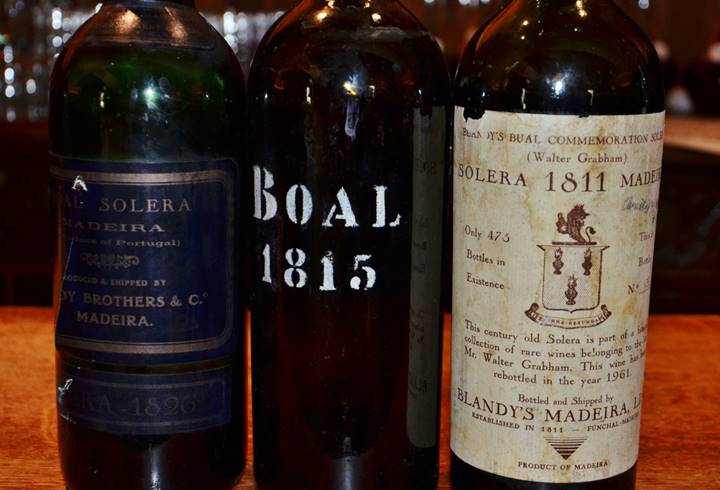
MB: 1826 Blandy's Bual Solera
Among the most familiar Madeira labels to collectors are the purple and gold labels used by Blandy's for their superb soleras released in the 1950s and 1960s. These Madeiras include 1863 Malmsey, 1864 Grand Cama do Lobos, 1808 Malmsey and this 1826 Bual. Of these four wines, the last two are by far the rarest. And what is particularly interesting about the 1826 Bual Solera is that the producer is not shown on the label as the usual "Blandy's Madeiras Lda." Instead, it reads “Blandy's Brothers & Co.,” a name that originated in the late 1800s, when Charles Ridpath Blandy and his sons disagreed so strongly about the future of the family business that the sons created their own company, Blandy's Brothers. Based on a number of factors, I suspect that this 1826 Solera was bottled between 1956 and 1960, and that it was based on the 1826 Campanário Walter Grabham left to the Blandy family on his death in 1955.
RH: 1826 Blandy’s Boal Solera Madeira – Impressions led me to believe this was in glass for a long time and it was the darkest color of the past half dozen bottlings with a greenish rim. Fragrant accents of cinnamon, a smoky/char note, iodine, coconut, brown sugar, leather and mahogany. A rich wine, smooth and seamless as it flowed across the palate; delivering mid-level acidity with a hint of mint and flavors of dried apricot, iced tea, golden raisins and loads of herbs. A well-made Blandy’s that was unable to hang in the company of the ’27 Serrado, which is unfair -- but nonetheless, it was nice to try this 1826 for the very first time. 92 points 4/5/14
MB: 1815 Boal
The year 1815 was golden for the British wine trade in Madeira. It was not only the year Wellington defeated Napoleon at Waterloo; it was also a fine vintage. So, it had a certain magic in the trade. Throughout the 1820s and 1830s, British shippers often sent an “1815 vintage” Madeira to customers desiring a fine “old” wine—leading one to wonder just how much wine was made in that providential year! As for this particular 1815 Boal, it’s difficult to discern whether this is from a British or Portuguese source. The stenciling suggests British, but the use of the word "Boal" (instead of "Bual") might suggest otherwise. An intriguing bottle I'm anxious to taste!
RH: 1815 Boal Vintage Madeira – Medium maple hue with ruby glints and golden meniscus. A cunning display of explosive aromas were the significant strength of this Boal, including quince, tropical ripe peach, toffee, mandarin orange and a nutty praline undertone. Elegant and expressive, light on the palate but medium-bodied with great purity of Boal character and precise citrusy acidity. Lip smacking grapefruit and lemony impressions upon entry, but sweeter almost Malvasia-like RS at its core, balanced by the aforementioned acid. Later on there were some additional sweet flavors of hazelnut and caramel. Richly textured, this 1815 was enjoyable and offered up a persistent finish. I had never seen this bottling before and hope to try it again someday. 92 points 4/5/14
MB: 1811 Blandy's Bual Commemoration Solera – The following originally appeared as a separate article in our tasting brochure …
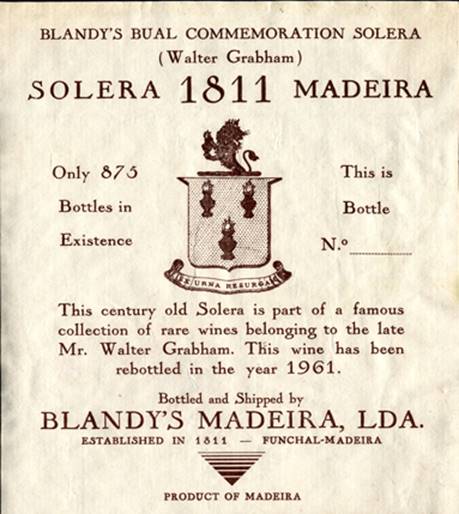
More than Meets the Eye - 1811 Blandy Commemoration Bual Solera
By Mannie Berk
Thanks to his marriage into the Blandy family, Dr. Michael Grabham (1840-1935) amassed a peerless collection of 18th and 19th century Madeiras. And Grabham’s collection was the basis of Blandy’s 1811 Commemoration Solera, which we are privileged to taste today, thanks to Bob Maliner. But what exactly is the 1811 Commemoration Bual and how did it come to be?
A few clues are provided by the wine’s front and back labels. The front label reads: "This century-old Solera is part of a famous collection of rare wines belonging to the late Mr. Walter Grabham. This wine has been rebottled in the year 1961."
The back label continues: "Dr. Michael Grabham who married Miss Mary Anne Blandy inherited through his wife a very fine cellar. This he left to his son Walter Grabham. Walter, who died in 1955, left the cellar to his cousins Graham and John Blandy. To mark the 150th anniversary of the founding of the house of Blandy, this wonderful collection of wines has been used as the basis of Blandy's Bual Commemoration Solera. The wines, which include vintages dating back to 1788, have been blended in 1961 with wines all over 100 years old to produce this truly magnificent and unique Solera."
A Different Kind of Solera
The 1811 is not a solera is the conventional sense of the word: it did not undergo fractional blending, with wine periodically removed and added. Instead, it resulted from a one-time blending of various old wines belonging to Walter Grabham.
The wine was a perfect storm. The Blandy family had acquired a stock of ancient wines that, despite their extraordinary pedigree, they viewed as problematic. And they needed a wine to celebrate the sesquicentennial of John Blandy’s entry into the Madeira trade. And so the decision was made to unbottle much of the Grabham collection to produce a new old wine.
The following are just a few of the wines that in 1955 passed from Walter Grabham to the Blandys and may have gone into this historic bottling: 1826 Blandy Campanário, 1858 Blandy Sercial, 1829 Blandy Porto de Cruz, 1788 Blandy Malmsey, 1827 Blandy Bual, 1827 Blandy Old London Particular, 1830 Blandy “Cask”, and the famous Blandy São Marthinho Challenger, which had sailed in barrel on the HMS Challenger Expedition in 1873. There’s even a distinct possibility that some of Grabham’s 1792 Blandy Madeira, the so-called “Napoleon Madeira,” might have gone into the blend.
Here’s what I think happened.
As the wine’s back label reports, the Blandys inherited Walter Grabham’s wines on his death in 1955. And in the autumn of 1960, Graham Blandy sold hundreds of bottles of these Grabham Madeiras to the Madeira Wine Association (of which the Blandys were the largest shareholders) for $8.75 a bottle. Included in the parcel were the 1792 and the Challenger. “They can well be made into a Solera,” Graham Blandy wrote to the MWA’s Horace Zino.
The Blandy’s did hold on to a few bottles of the 1792 and the Challenger, and some of these bottles have been passed down through the Blandy family. But everything else went to the MWA, where the bottles apparently were emptied for blending. And I suspect that much of it went into the Commemoration Bual which was produced the next year.
But why were such historic Madeiras deemed best for blending? In 1956, after Walter Grabham’s death, Graham Blandy asked Tom Mullins, the managing director of the Madeira Wine Association, to taste through the Grabham wines. Mullins and his wife opened the wines over a series of evenings. Mullins reported back to Graham Blandy: “In my view they should only be served as curiosities and preferably at the beginning of the dinner or lunch, with the soup. I do not think that they will bring any credit to the name of Blandy, nor encourage people to drink Madeiras.”
Even the famous 1792 failed to impress Mullins, who could only bring himself to write: “Fair — better on taste than on nose. Might be served after dinner.”
The Challenge of Old Glass-Aged Madeiras
How could such historic wines have been so disappointing to Mullins—a man with more than thirty years in the Madeira Trade? The Grabham wines Blandy had in the greatest quantities had been in bottle since the 1830s and 1840s, and so they would have suffered from serious bottle stink. Apparently, Mullins didn’t consider it necessary to give the wines the weeks or even months of air they needed to recover from a century or more in bottle. It appears that he just “popped and poured,” and he took what he tasted and smelled at face value.
As for the 1792, at least a dozen bottles were included in the parcel sold to the MWA for blending. So, there is probably a tiny amount of this wine in what we are tasting today. A much larger number of bottles of Grabham’s 1792 had been emptied in 1957, to produce the 1792 Blandy’s Extra Reserve Solera, which commemorated Elizabeth II’s visit to the island.
But how was the 1811 Solera actually created? In 1960, Horace Zino, who succeeded Mullins at the MWA, described making another Grabham-based solera “by adding a very old wine aged in oak.” If this happened with the 1811 (and I think it’s likely it did), the oak-aged wine would presumably have been a Bual, since few of the Grabham wines were Buals.
The oak-aged wine must have also been quite sweet, since the Grabham wines were undoubtedly very dry. Not only had the Grabham wines been in glass for a very long time, we can rely on Tom Mullins’ recommendation that they would have been best served “at the beginning of the dinner or lunch, with the soup.”
The legacy of all of this is clear: one great, and now painfully rare, Madeira: the 1811 Commemoration Bual Solera. But in hindsight, it is also somewhat tragic that many of the surviving bottles of Madeira’s greatest private collection were sacrificed for blending.
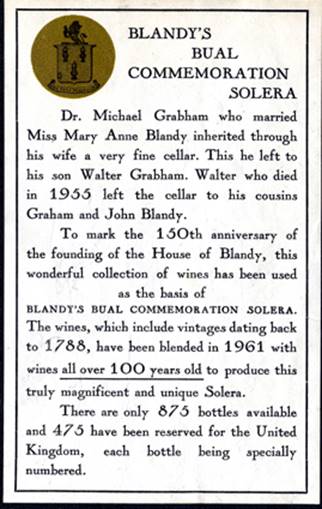
RH: 1811 Blandy’s Boal “Commemoration Solera” Madeira – Back in 2011, I was fortunate to be invited to a tasting of Blandy’s Madeira in San Francisco where it was announced that the Symington Family Estates had sold the lion’s share of their majority stake in the Madeira Wine Company back to the Blandy’s Group to coincide with Blandy’s bicentennial anniversary. It was a great celebration with both families in attendance. On that occasion, I had the opportunity to taste the 1811 Solera, but it was a different and far more recent bottling than this one. Today’s Grabham bottling had some off-putting notes of fresh paint, plastic and pleather, but most blew off after the first hour. More pleasing aromas prevailed with mostly ripe tropical fruits, saline, Indian spices, roasted nuts and toffee. Medium weight with a velvety texture, the palate also had some issues, presenting a bitter nut skin flavor, but it came around in glass and while it lacked Boal character the honey, walnut, nectarine and spiciness of the wine was quite pleasing, bolstered by ample acidity and a long finish. 89 points 4/5/14
MB: Henriques & Henriques W.S. Boal
This bottled was purchased from the estate of John Cossart in 2011. John had been managing director of Henriques & Henriques, and this bottle belonged to his father, Peter, who had managed H & H from the 1950s through the 1980s. It was one of many H & H bottles that John inherited from his father. Alex Liddell's 1998 book, Madeira, made famous the four ancient, yet undated, Madeiras belonging to Henriques & Henriques. Liddell called them the “Heavenly Quartet,” thanks to their wonderful quality. The W.S. Boal was one of these wines. Like the Leacocks and Blandys at the Madeira Wine Association, Peter Cossart took examples of the greatest wines out of the company inventory for his personal collection. His son John inherited these wines on his father's death in 1991. And on John's death, the collection was sold by John's children to The Rare Wine Co. The bottle we're tasting today belonged to John. Its age is indeterminant, but John believed that this group of wines was already considered "old" when H & H was founded in 1850 and some may date to the late 18th century. Like the other wines in the John Cossart collection, this wine was aired for about six months in demijohn, before being rebottled and recorked in late 2011.
RH: Henriques & Henriques “WS” Boal Vintage Madeira – Medium caramel color with a dark green edge. A stunningly complex nose of cedar cigar wrappers, lime zest, beef bouillon, glove leather and torched sugar really was one of the most unique in a long line of finely appointed Boals whiffed throughout this tasting. While I preferred the aromatic profile to the palate itself, I did enjoy drinking this H&H rarity, a member of the infamous, “Heavenly Quartet”. Light weight if not a bit “thin” for my tastes, but the electrically charged acidity provided the lift and exactitude enhancing this Boal’s overall delivery. A core of dangerously delicious flavors emerged including poached pear, cinnamon stick, cashew, and a rare essence of buttery brioche. Very enjoyable overall, as it continued to improve throughout the tasting and by the end, the medium length finish offered lots of complexity. 93 points 4/5/14
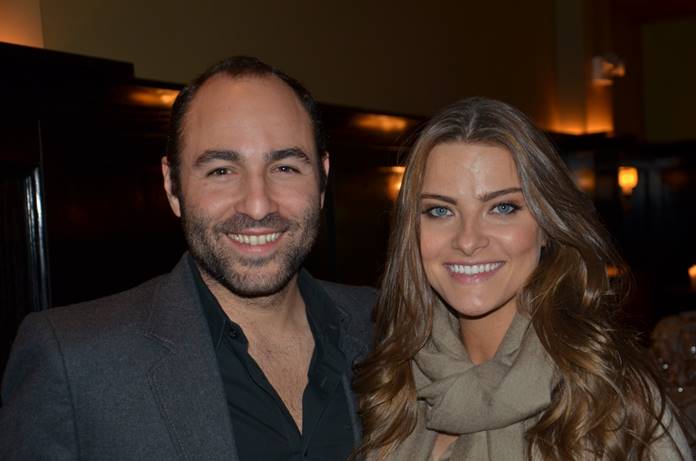
Justin Ashourian and Crystal Fanale having a great time at Del Posto
MB: Henriques & Henriques Grand Old Boal
Another member of the Heavenly Quartet. This bottle was purchased by RWC from Henriques & Henriques a few years ago. Its age is also unknown, but it’s believed to have already been an old wine when H & H was founded in 1850.
RH: Henriques & Henriques Grand Old Boal Vintage Madeira – This is likely the only time in my life that I will ever get to taste two bottles of the Heavenly Quartet” back-to-back. An ancient bottling and worthy of its moniker, it presented a medium-dark amber tone with a tawny-green edge. Delivering a knockout nose that just kept improving and adding peripherals throughout the afternoon, it was loaded with figs, caramel apple, spearmint and tangerine early, with scents of ripe apricot and peach compote later on. As much as the previous bottling of H&H delivered the goods, the quality here was ratcheted up a notch and was really impressive. This Grand Old Boal offers excellent concentration and was viscous if not downright dense and was almost seemed syrupy had it not been for the tactile cut of the acidity which defined precision. It’s a mellifluous opulent yet racy Madeira with flavors of blood orange, white peach, zesty lime and crème caramel. The high level of RS was so well integrated adorned by a soft and creamy mouthfeel which all led up to a long and complex aftertaste. 95 points 4/5/14
MB: 1802 Barbeito Boal
This 212-year-old treasure came from Ricardo Freitas’ family, and is quite rare. Only a few bottles of 1802 Bual have ever appeared at auction, and these have generally lacked a producer’s or shipper’s name. A fitting conclusion for a once-in-a-lifetime tasting.
RH: 1802 Barbeito Boal Solera Madeira – Any thoughts that due to their shared vintage that this Madeira could be within the same stratosphere as the 1802 Acciaioly Terrantez was quickly dispelled after the first sip. Nonetheless, it proved to be a beautiful Boal and presented a medium tawny-amber hue with a greenish-amber meniscus. A distinctive scent dominated by desiccated fruits such as figs, raisins and prunes, some high toned iodine, a spicy herbal note and early bottle funk equated to an intriguing complex bouquet. Almost Malvasia sweet, with crème brûlée, candied pecans, treacle and Sultana combined with near perfect acidity to deliver a well-balanced wine with a lengthy finish; hitting on all cylinders. Subtle, harmonious and graceful at 212 years of age, who could ask for anything more? An excellent Barbeito and great way to finish our tasting! 94 points 4/5/14
Bual / Boal: A grape brief by Richard Mayson

Bual (or Boal in Portuguese) is a name that covers not one but a number of grape varieties in Portugal. Professor Cincinnato da Costa, writing in his tome O Portugal Viticola / Le Portugal Vinicole at the turn of the twentieth century lists no less than sixteen sub-varieties. These include tantalising names like Boal carrasquenho, Boal de Alicante, Boal pardo (‘grey’ Boal) Boal Calhariz, Boal desembargador (‘umembargoed’ Boal), Boal roxo (purple Boal), Boal Frio (‘cold’ Boal), Boal liso (‘smooth’ Boal) Boal ratinho (‘small mouse’ Boal), Boal ramilhete (floral ‘nosegay’ Boal) and Boal Bonifacio. Apparently John Leacock always referred to the grape as ’Boyal’.
The Boal growing on Madeira, also known as the Boal Cachudo (cacho meaning ‘bunch’), has had the official and rather confusing official title of Malvasia Fina since 2000. It almost certainly originated on the Portuguese mainland (or continente as it is known in Madeira) having been planted in the Douro and Dão for centuries. In Wine Grapes (Robinson et al.) viticulturalist Rolando Faustino suggests that due to its wide genetic diversity it is probably from the Douro but neither Dão nor the Lisbon region can be ruled out. Interestingly, Cincinnato da Costa distinguishes Boal Cachudo and Malvasia Fina as separate grape varieties placing the first in the Lisbon region (as well as Madeira) and the second in the Douro.
Under the name Malvasia Fina it is the second most planted white grape in the Douro and therefore ends up in almost all white Port. Rebello de Fonseca heaped praise on the grape in the nineteenth century saying ‘you can eat it, make raisins from it as well as wonderful wine. Among white grapes only Moscatel is better’. In fact in the Douro it was sometimes known by farmers as the Malvasia de Passa because of its tendency to raisinize and shrivel on the vine. From my experience in Portugal (and elsewhere) grapes that are good to eat rarely make the best wine. In Portugal this variety is also known by the local names Arinto do Dão and Assário. Boal is also grown on the Azores. Recent DNA parentage has shown that the Boal Ratinho once grown widely for fortified wine in Carcavelos is an offspring of Malvasia Fina and Síria grape (the latter also known as Códega).
Malvasia Fina (aka Boal Cachudo) is a relatively easy grape to grow. It buds late and ripens early, its only significant drawback being its susceptibility to powdery mildew (Oidium). Its bunches are large, hence the name. On the continente it is not especially prized as a variety and only rarely appears as a varietal wine. But on Madeira, Boal is the second most planted of all the white grape varieties (formerly known as ‘noble’ grapes, although so called ‘Malvasia’ is in fact a cover for a number of varieties.). Boal is traditionally found growing on warmer sites on the south side of the island, usually at 100 – 300 metres above sea level. Today, the best wines originate from small plots in Campanário, Calheta, Arco de Calheta and Ponta do Pargo to the west of Funchal. It does not perform well on the cooler and damper north side of the island and there is very little planted there as a result. Unlike some of the other white grapes (e.g. Terrantez and Sercial) there is seemingly no shortage of Boal even though the total registered area is no more than 20 hectares out of a total vineyard area of nearly 500 hectares (8.7 ha in Calheta, 6.6ha in Camara de Lobos and 3.6 ha in Ribeira Brava). Boal is capable of ripening to between 11º and 13º baumé but the average baumé in recent years has been less than 10, more a reflection of yield than anything else. Nevertheless it produces wines that are medium sweet or medium rich in style. Until Portugal joined the European Union in 1986, most medium sweet wine was labelled ‘Boal’ or ‘Bual’ as an indication of style rather than actually being made from the stated grape.
In his book, Madeira, the Island Vineyard, Noel Cossart says little about Boal as a grape but writes of the wine that ‘Bual was a great favorite in officers’ messes and clubs in India, being lighter than Malmsey or Port.’ My late father-in-law, Richard Blandy, (who chaired Blandy’s from 1986 to 2001) always professed that Bual was his favorite style of Madeira wine and advocated drinking it with curry. I have tried this and the combination really works!
Richard Mayson 13-3-14
Cincinnato da Costa, B.C. O Portugal Vitícola, Lisbon 1900
Cossart N., Madeira, The Island Vineyard, London 1984 and Revised Second Edition, Sonoma, 2011
Mayson R.J. Port and the Douro, London, 1999, Second ed. 2004, Third ed. Oxford 2012.
Robinson J., Harding J., Vouillamoz J., Wine Grapes, London 2012
Richard Mayson is currently writing a book on Madeira wine to be published by Infinite Ideas, Oxford.
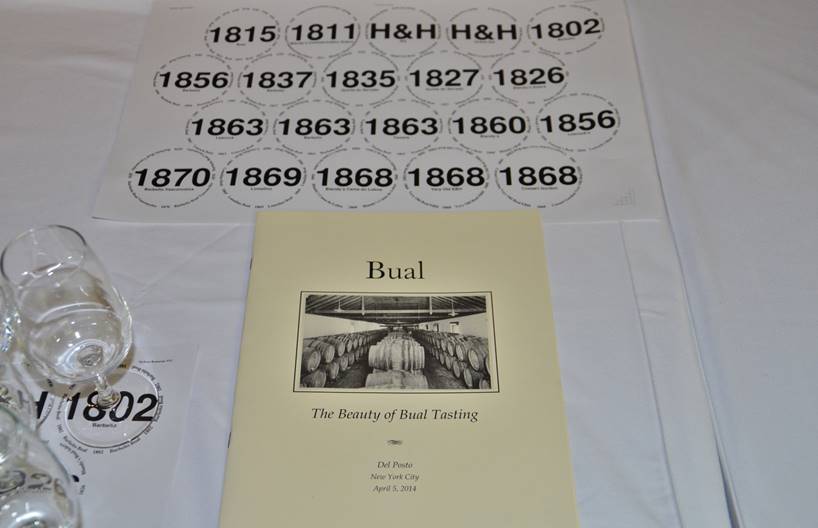

Leave A Comment
You must be logged in to post a comment.